Pisa Baptistery
The Pisa Baptistery of St. John (Italian: Battistero di San Giovanni) is a Roman Catholic ecclesiastical building in Pisa, Italy. Construction started in 1152 to replace an older baptistery, and when it was completed in 1363, it became the second building, in chronological order, in the Piazza dei Miracoli, near the Duomo di Pisa and the cathedral's free-standing campanile, the famous Leaning Tower of Pisa. The baptistery was designed by Diotisalvi, whose signature can be read on two pillars inside the building, with the date 1153.[1]
| Pisa Baptistery | |
|---|---|
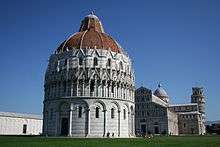 Baptistery with the Pisa Cathedral and the Leaning Tower of Pisa | |
| Religion | |
| Affiliation | Roman Catholic |
| Location | |
| Location | Piazza del Duomo, 23, 56126 Pisa PI, Italy |
 Shown within Italy | |
| Geographic coordinates | 43°43′24″N 10°23′38″E |
| Architecture | |
| Completed | 1152 |
Description
The largest baptistery in Italy, it is 54.86 m high, with a diameter of 34.13 m. The Pisa Baptistery is an example of the transition from the Romanesque style to the Gothic style: the lower section is in the Romanesque style, with rounded arches, while the upper sections are in the Gothic style, with pointed arches. The Baptistery is constructed of marble, as is common in Italian architecture.
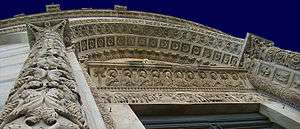
The portal, facing the facade of the cathedral, is flanked by two classical columns, while the inner jambs are executed in Byzantine style. The lintel is divided in two tiers. The lower one depicts several episodes in the life of St. John the Baptist, while the upper one shows Christ between the Madonna and St John the Baptist, flanked by angels and the evangelists.
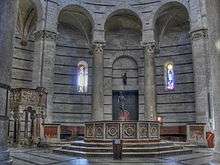
The interior is overwhelming and lacks decoration. The octagonal font at the centre dates from 1246 and was made by Guido Bigarelli da Como. The bronze sculpture of St. John the Baptist at the centre of the font, is a work by Italo Griselli.
The pulpit was sculpted between 1255-1260 by Nicola Pisano, father of Giovanni, the artist who produced the pulpit in the Duomo. The scenes on the pulpit, and especially the classical form of the nude Hercules, show Nicola Pisano's qualities as the most important precursor of Italian Renaissance sculpture by reinstating antique representations: surveys of the Italian Renaissance often begin with the year 1260, the year that Nicola Pisano dated this pulpit.
Constructed on the same unstable sand as the tower and cathedral, the Baptistery leans 0.6 degrees toward the cathedral. Originally the shape of the Baptistery, according to the project by Diotisalvi, was different. It was perhaps similar to the church of Holy Sepulchre in Pisa, with its pyramidal roof. After the death of the architect, Nicola Pisano continued the work, changing the style to the more modern Gothic one. Also an external roof was added giving the shape of a cupola. As a side effect of the two roofs, the pyramidal inner one and the domed external one, the interior is acoustically perfect,[2] making of that space a resonating chamber.
The exterior of the dome is clad with lead sheets on its east side (facing the cathedral) and red tiles on its west side (facing the sea), giving a half grey and half red appearance from the south.[3]
 The Pisa Baptistery
The Pisa Baptistery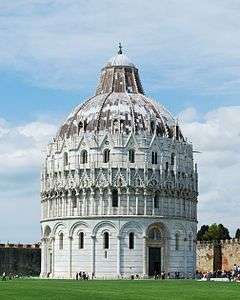 The Pisa Baptistery
The Pisa Baptistery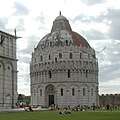 View from north-east showing the two colours of the dome
View from north-east showing the two colours of the dome%2C_Pisa%2C_Tuscany%2C_Central_Italy-2.jpg) Baptistery columns
Baptistery columns%2C_Pisa%2C_Tuscany%2C_Central_Italy-3.jpg) Baptistery dome
Baptistery dome Baptistery font
Baptistery font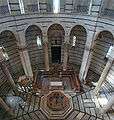 Baptistery interior
Baptistery interior A fisheye view of the interior
A fisheye view of the interior
References
- In the medieval Pisan calendar, 1153 corresponded to 1152.
- Article about acoustics in the baptistery (in Italian) Archived 2008-03-31 at the Wayback Machine
- Opera della Primaziale Pisana